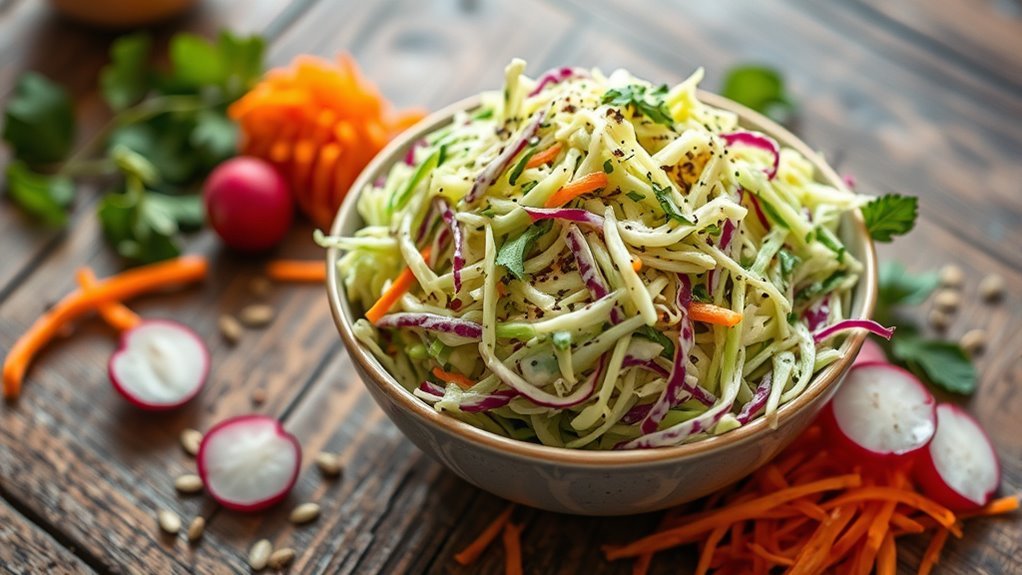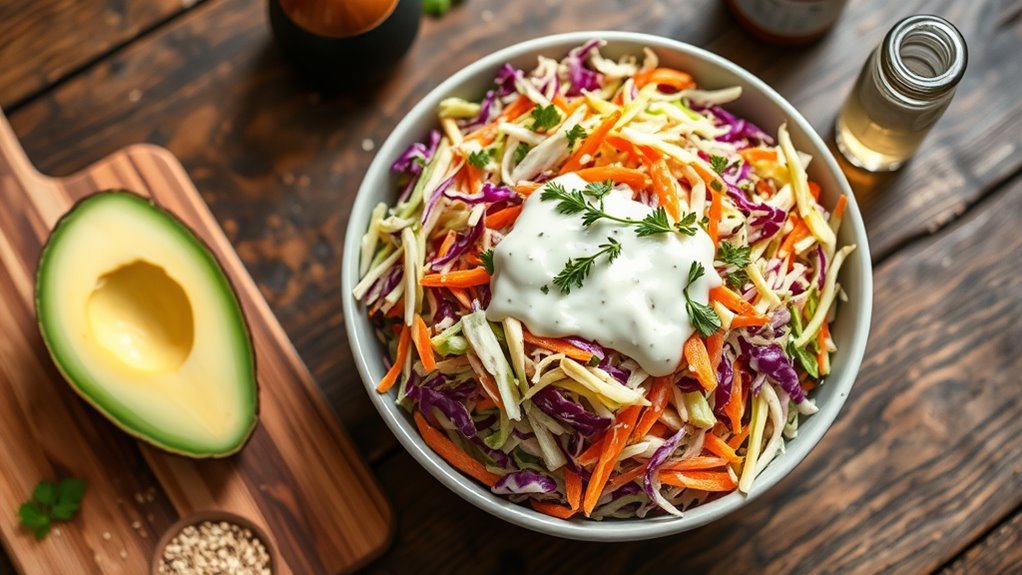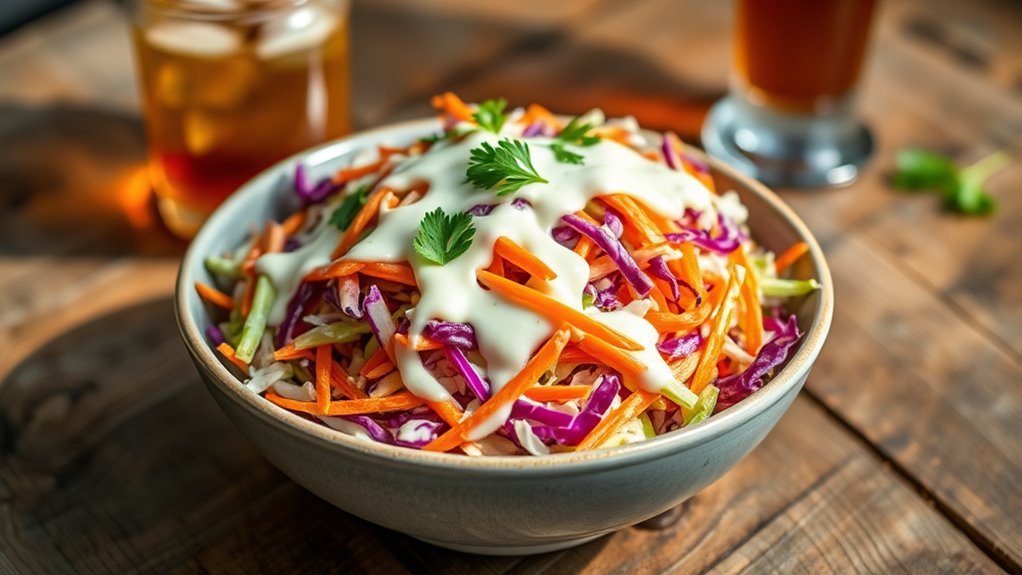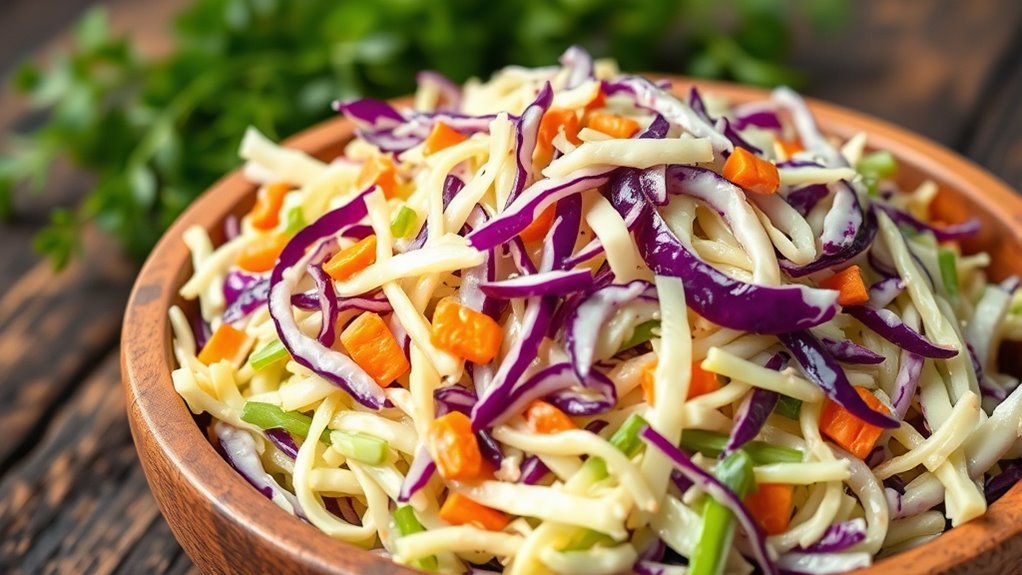Coleslaw can definitely be keto-friendly if you choose low-carb ingredients. Stick to green or Napa cabbage and avoid sugary dressings. Use mayonnaise or sour cream as your base, opting for sugar-free and low-carb alternatives. Healthy fats from dressings like olive oil enhance flavor and help meet your dietary goals. Plus, coleslaw is rich in fiber and vitamins. There are many tasty variations to explore that align with keto principles, which you’ll find out more about.
Understanding the Basics of Coleslaw

Coleslaw, a popular salad dish, primarily consists of finely shredded raw cabbage and various seasonings, often combined with a creamy dressing. Its origins trace back to ancient Rome, where a similar dish was made with cabbage, eggs, and vinegar. The coleslaw that people are familiar with today began emerging in 18th-century Europe, particularly in the Netherlands, where it was known as “koolsla,” meaning “cabbage salad.” As it traveled to America, coleslaw history evolved, adapting to local tastes and ingredients. By the mid-19th century, it became a staple at barbecues and picnics. Understanding these origins can deepen your appreciation for coleslaw as more than just a side dish, but a culinary reflection of cultural exchanges and historical transformations.
Key Ingredients for Keto-Friendly Coleslaw

When considering a keto-friendly coleslaw, it’s essential to focus on low-carb ingredients that align with ketogenic dietary principles. Start with cabbage types that are low in carbohydrates, such as green cabbage or Napa cabbage. These varieties not only keep the carb count down but also add crunch and flavor. You’ll want to avoid higher-carb options like red cabbage if you’re strictly monitoring your intake.
For dressing options, opt for a base of mayonnaise or sour cream, which are both keto-approved. Just be cautious with added sugars; make sure to select sugar-free or low-carb alternatives. By choosing the right cabbage and dressing, you can create a delicious, keto-friendly coleslaw that complements your dietary lifestyle without compromising on taste.
How to Make a Keto-Friendly Coleslaw Dressing

To create a keto-friendly coleslaw dressing, you’ll want to focus on selecting low-carb ingredients, such as mayonnaise or Greek yogurt as your base. Incorporating healthy fats like olive oil or avocado oil can enhance the flavor and texture while keeping your carb count low. Additionally, consider flavor enhancements such as apple cider vinegar, mustard, or spices to elevate your dressing without adding unnecessary sugars.
Low-Carb Ingredients Selection
While many traditional coleslaw dressings rely on high-carb ingredients like sugar and mayonnaise, you can create a keto-friendly version by carefully selecting low-carb alternatives. Start by exploring different cabbage types, such as green or red, as they’re low in carbs and add crunch. For dressing alternatives, consider using vinegar-based dressings or creamy options with low-carb mayonnaise or Greek yogurt. Sweeten your dressing with a keto-friendly sweetener like erythritol instead of sugar. Additionally, spices like garlic powder or celery seed can enhance flavor without adding carbs. By choosing these low-carb ingredients, you can enjoy coleslaw that fits seamlessly into your keto lifestyle, providing freedom to indulge without compromising your dietary goals.
Healthy Fats Options
Although many traditional coleslaw dressings rely on unhealthy fats, you can create a keto-friendly version by choosing healthier fat options that align with your dietary goals. Consider using avocado oil or olive oil as your base, both rich in monounsaturated fats. You might also explore mayonnaise alternatives made with avocado or coconut cream for a creamy texture. Incorporating nut butters can add flavor and healthy fats, while adding a variety of seeds can enhance the nutritional profile. Don’t forget the benefits of fatty fish, which can be mixed in for extra richness. For a final touch, cheese options and nut toppings can elevate your coleslaw, ensuring it’s satisfying and aligned with your keto lifestyle.
Flavor Enhancements Ideas
Creating a flavorful keto-friendly coleslaw dressing doesn’t have to be complicated. Start with a base of mayonnaise or Greek yogurt, then enhance it with spice blends like garlic powder or smoked paprika for depth. Consider herb infusions, using fresh dill or parsley to elevate freshness. Adding citrus zest can brighten the dressing, while a sweeteners comparison, such as erythritol or stevia, can satisfy your sweet tooth without the carbs. For texture, nut toppings like sliced almonds or walnuts can introduce crunch factors, enhancing the overall experience. Experiment with dressings variety by mixing and matching these elements to discover unique flavor pairings that keep your coleslaw exciting and aligned with your keto lifestyle.
Variations of Keto Coleslaw Recipes
When it comes to keto coleslaw, there are several delicious variations that can suit different palates and dietary needs. You can experiment with creative toppings and unique spices to elevate your dish. Here are a few ideas:
| Variation | Key Ingredients |
|---|---|
| Creamy Avocado | Avocado, mayo, lime juice |
| Asian-Inspired | Cabbage, sesame oil, ginger |
| Spicy Jalapeño | Green cabbage, jalapeños, cumin |
These variations not only maintain the low-carb integrity of coleslaw but also introduce exciting flavors. Whether you prefer the richness of avocado or the zing of jalapeño, these adaptations can make your keto coleslaw both satisfying and enjoyable. Enjoy the freedom to customize to your taste!
Tips for Serving and Storing Coleslaw
To guarantee your coleslaw remains fresh and flavorful, it’s essential to take into account both serving and storing techniques. Here are some effective tips:
To keep your coleslaw fresh and tasty, focus on proper serving and storage methods.
- Serving Suggestions: Serve coleslaw chilled to enhance its crispness. Consider pairing it with grilled meats or as a topping for keto-friendly tacos for added texture and flavor.
- Storage Tips: Store coleslaw in an airtight container to minimize exposure to air, which can lead to wilting.
- Timing: It’s best to prepare coleslaw just a few hours before serving to maintain its crunch. If you need to make it ahead, mix the dressing separately and add it right before serving.
Nutritional Benefits of Coleslaw on a Keto Diet
Coleslaw can be a valuable addition to your keto diet due to its low-carb vegetable base, primarily consisting of cabbage. Its healthy fats content, especially when made with dressings like mayonnaise or avocado oil, supports your daily fat intake. Additionally, its nutrient density provides essential vitamins and minerals, making it a smart choice for maintaining overall health while staying in ketosis.
Low-Carb Vegetable Base
Although many traditional side dishes are high in carbohydrates, coleslaw offers a low-carb vegetable base that aligns well with keto dietary guidelines. By selecting various cabbage varieties, you can customize your coleslaw while keeping carbs in check. Here are three nutritional benefits of this versatile dish:
- Low in Carbs: Cabbage is a cruciferous vegetable with minimal carbohydrates, making it a perfect choice for your keto meals.
- Rich in Fiber: It provides essential dietary fiber, promoting digestive health while keeping you feeling full.
- Vitamins and Minerals: Cabbage is packed with nutrients like vitamin C and K, supporting overall health.
With various dressing options available, you can easily create a tasty, keto-friendly coleslaw that satisfies your cravings.
Healthy Fats Content
Incorporating healthy fats into your coleslaw can enhance its nutritional profile while aligning with keto principles. By using avocado oil as a dressing, you not only add a rich, buttery flavor but also infuse the dish with monounsaturated fats, which support heart health and may aid in weight management. Additionally, consider incorporating coconut cream for a creamy texture and a dose of medium-chain triglycerides (MCTs), known for their quick energy conversion and potential to boost ketone production. These healthy fats help keep you satiated and can improve nutrient absorption. So, when crafting your coleslaw, prioritize these fats to guarantee it’s not just keto-friendly but also a delicious and nutritious addition to your diet.
Nutrient Density Analysis
When considering nutrient density, coleslaw can be surprisingly beneficial on a keto diet, particularly due to its base ingredients. Here are some key nutrient sources that make coleslaw a smart choice:
- Cabbage: Packed with vitamins C and K, cabbage also provides antioxidants that support overall health.
- Carrots: While slightly higher in carbs, carrots contribute beta-carotene and fiber content, enhancing digestive health.
- Dressings: Opting for avocado or olive oil-based dressings adds healthy fats, boosting nutrient absorption.
The fiber content in coleslaw can help maintain gut health, a crucial aspect of any diet. Overall, when prepared mindfully, coleslaw can be a vibrant, low-carb addition to your keto meals, offering essential nutrients while keeping your macros in check.


